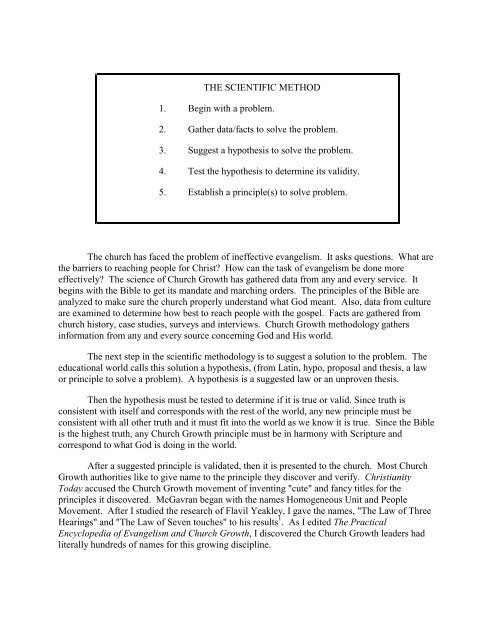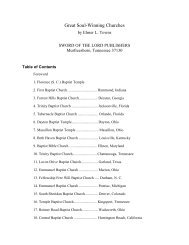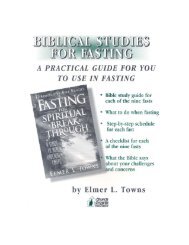PUTTING AN END TO WORSHIP WARS - Elmer Towns
PUTTING AN END TO WORSHIP WARS - Elmer Towns
PUTTING AN END TO WORSHIP WARS - Elmer Towns
- TAGS
- worship
- elmer
- towns
- elmertowns.com
You also want an ePaper? Increase the reach of your titles
YUMPU automatically turns print PDFs into web optimized ePapers that Google loves.
THE SCIENTIFIC METHOD<br />
1. Begin with a problem.<br />
2. Gather data/facts to solve the problem.<br />
3. Suggest a hypothesis to solve the problem.<br />
4. Test the hypothesis to determine its validity.<br />
5. Establish a principle(s) to solve problem.<br />
The church has faced the problem of ineffective evangelism. It asks questions. What are<br />
the barriers to reaching people for Christ? How can the task of evangelism be done more<br />
effectively? The science of Church Growth has gathered data from any and every service. It<br />
begins with the Bible to get its mandate and marching orders. The principles of the Bible are<br />
analyzed to make sure the church properly understand what God meant. Also, data from culture<br />
are examined to determine how best to reach people with the gospel. Facts are gathered from<br />
church history, case studies, surveys and interviews. Church Growth methodology gathers<br />
information from any and every source concerning God and His world.<br />
The next step in the scientific methodology is to suggest a solution to the problem. The<br />
educational world calls this solution a hypothesis, (from Latin, hypo, proposal and thesis, a law<br />
or principle to solve a problem). A hypothesis is a suggested law or an unproven thesis.<br />
Then the hypothesis must be tested to determine if it is true or valid. Since truth is<br />
consistent with itself and corresponds with the rest of the world, any new principle must be<br />
consistent with all other truth and it must fit into the world as we know it is true. Since the Bible<br />
is the highest truth, any Church Growth principle must be in harmony with Scripture and<br />
correspond to what God is doing in the world.<br />
After a suggested principle is validated, then it is presented to the church. Most Church<br />
Growth authorities like to give name to the principle they discover and verify. Christianity<br />
Today accused the Church Growth movement of inventing "cute" and fancy titles for the<br />
principles it discovered. McGavran began with the names Homogeneous Unit and People<br />
Movement. After I studied the research of Flavil Yeakley, I gave the names, "The Law of Three<br />
Hearings" and "The Law of Seven touches" to his results 1 . As I edited The Practical<br />
Encyclopedia of Evangelism and Church Growth, I discovered the Church Growth leaders had<br />
literally hundreds of names for this growing discipline.
















